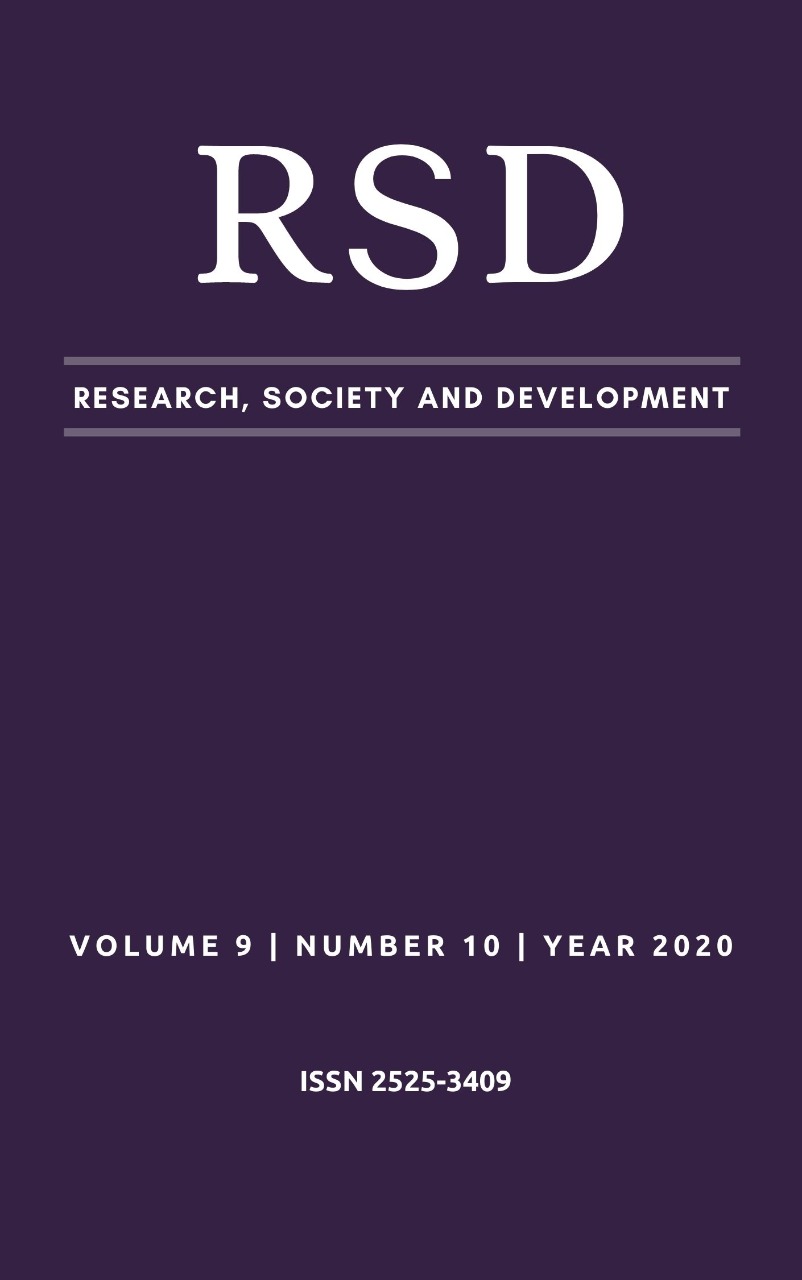Antibacterial and antifungal activities herbácia Zingiber Officinale in dentistry: a literature review
DOI:
https://doi.org/10.33448/rsd-v9i10.9141Keywords:
Antibacterial agents, Antifungal agents, Dental biofilm, Zingiber officinale.Abstract
The pathogenic dental biofilm formed by species presents itself as a serious problem, since it contributes to the development of oral and bodily diseases. In this sense, Dentistry stands out for expanding knowledge about the oral ecosystem and performing procedures aimed at reducing its pathogenicity and improving oral health. Thus, technological advances and indiscriminate application of antibiotics have made bacterial strains resistant, with a great search for safer, more natural and effective methods. Therefore, the use of plants for healthy treatments is an area of great study in Dentistry. In the present literature review, we sought to analyze the species Zingiber officinali with its antimicrobial and antibiofilm activity. For this study, materials were searched at the BIREME, CINAHL, Cochrane Library, Embase, Google Schoolar, PubMed, Science Direct, published until August 2020. The search for the articles was carried out in August 2020, of the 3,401 studies were refined in 18. The findings showed that the plant Zingiber officinale has the capacity to inhibit certain bacteria in vitro, such as Bacillus sp., Escherichia coli, Pseudomonas aeruginosa, Streptococcus mutans and fungi, like Candida albicans. Thus, studies in the area are still needed in order to prove its effectiveness in vivo, to analyze the toxicity, drug interactions and side effects of the plant.
References
Aghazadeh, M., et al. (2016). Survey of the Antibiofilm and Antimicrobial Effects of Zingiber officinale (in Vitro Study). Jundishapur Journal of Microbiology. 9(2), 1-4.
Avcioglu, N. H., Sahal, G., Bilkay, I. S. (2016) Antibiofilm effects of Citrus limonum and Zingiber officinale oils on biofilm formation of Klebsiella ornithinolytica, Klebsiella oxytoca and Klebsiella terrigena species. African Journal of Traditional Complementary Alternative Medicines. 13(6),61-67.
Cavalcante, R. As plantas na Odontologia:Um guia prático. (2019) (3a ed.), Cavalcante,R.
Ghasemzadeh, A., et al. (2018). Formation of 6-, 8- and 10-Shogaol in Ginger through Application of Different Drying Methods: Altered Antioxidant and Antimicrobial Activity. Molecules. 23(7),1-12.
Gregio, A. M. T., et al. (2006). Ação antimicrobiana do Zingiber officinale frente á microbiota bucal. Estudos de Biologia. 28(62), 61-66.
Gull, I., et al. (2012). Inhibitory effect of Allium sativum and Zingiber officinale extracts on clinically important drug resistance pathogenic bacteria. Annals of Clinical Microbiology and Antimicrobials. 11(8), 10-16.
Guo, T., et al. (2017). Two new monoterpenoid glycosides from the fresh rhizome of Tongling White Ginger (Zingiber officinale). Natural Product Research. 32(1), 71-76.
Hasan, S., Danishuddin, M., Khan, A. U. (2015). Inhibitory effect of Zingiber officinale towards Streptococcus mutans virulence and caries development: in vitro and in vivo studies. BMC Microbiology. 15(1), 1-14.
Jain, I., et al. (2015) Use of Traditional Indian Plants in the inhibition of Caries- Causing Bacteria- Streptococcus mutans-. Brazilian Dental Journal. 26(2), 110 115.
Jami, S. G., Araujo, P. D. H. (2017). Efecto antimicrobiano del extracto, aceite de jengibre (zingiber officinale) sobre cepas de enterococcus faecalis: Estudio in vitro. ODONTOLOGÍA. 19(1), 89-97.
Karuppiah, P., Rajaram, S. (2012). Antibacterial effect of Allium sativum cloves and Zingiber officinale rhizomes against multiple-drug resistant clinical pathogens. Asian Pacific Journal of Tropical Biomedicine. 2(8), 597-601.
Kim, H. S., Park, H. D. (2013) Ginger Extract Inhibits Biofilm Formation by Pseudomonas aeruginosa PA14. PLOS ONE. 8(9), 1-16.
Kumar, L., Chhibber, S., Harjai, K. (2013). Zingerone inhibit biofilm formation and improve antibiofilm efficacy of 2 ciprofloxacin against Pseudomonas aeruginosa PAO1. Fitoterapia. 90, 73-78.
Lee, J. H., et al. (2018). Antibiofilm and Antivirulence Activities of 6-Gingerol and 6-Shogaol Against Candida albicans Due to Hyphal Inhibition. Frontiers in Cellular and Infection Microbiology. 8(299), 1-10.
Marsh & Martin. Microbiologia Oral. (6a ed.), Elsevier Health Science, 2018.
Miari, et al. (2020) Natural products and polysorbates: Potential Inhibitors of biofilm formation in Pseudomonas aeruginosa. The Journal of infection Developing Countries. 14(6), 580-588.
Park, M., Jungdon, B. A. E, Dae-Sil L. E. E. (2008) Antibacterial Activity of [10]-Gingerol and [12]-Gingerol isolated from Ginger Rhizome Against Periodontal Bacteria. Phytotherapy Research. 22(11), 1446-1449.
Pereira, A. S., et al. (2018). Metodologia da pesquisa científica. [e-book]. Santa Maria. Ed. UAB/NTE/UFSM.
Pozzati, P., et al.(2008). In vitro activity of essential oils extracted from plants used as spices against fluconazole-resistant and fluconazole-susceptible Candida spp. Canadian Journal of Microbiology. 54(11), 950- 956.
Rampogu, S., et al. (2018). Ginger (Zingiber officinale) phytochemicals gingerenone ‑A and shogaol inhibit SaHPPK: molecular docking, molecular dynamics simulations and in vitro approaches. Annals of Clinical Microbiology and Antimicrobials. 17(1), 1-15.
Valera, M. C., et al. (2016). Action of Chlorhexidine, Zingiber officinale on Candida albicans, Enterococcus faecalis, Escherichia coli, and Endotoxin in the Root canals. The Journal of Contemporary Dental Practice. 17(2), 114-118.
Downloads
Published
Issue
Section
License
Copyright (c) 2020 Natália Franco Brum; Mariana Sobreira Bezerra; Aline Sobreira Bezerra; Gabriela Scortegagna de Souza; Patricia Kolling Marquezan

This work is licensed under a Creative Commons Attribution 4.0 International License.
Authors who publish with this journal agree to the following terms:
1) Authors retain copyright and grant the journal right of first publication with the work simultaneously licensed under a Creative Commons Attribution License that allows others to share the work with an acknowledgement of the work's authorship and initial publication in this journal.
2) Authors are able to enter into separate, additional contractual arrangements for the non-exclusive distribution of the journal's published version of the work (e.g., post it to an institutional repository or publish it in a book), with an acknowledgement of its initial publication in this journal.
3) Authors are permitted and encouraged to post their work online (e.g., in institutional repositories or on their website) prior to and during the submission process, as it can lead to productive exchanges, as well as earlier and greater citation of published work.


